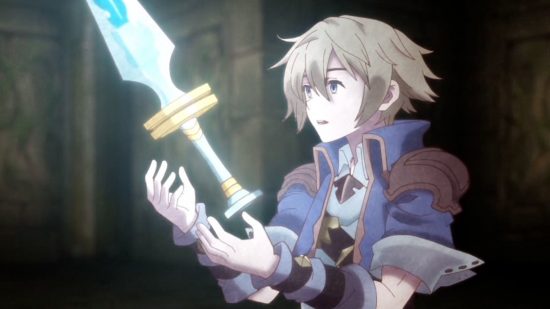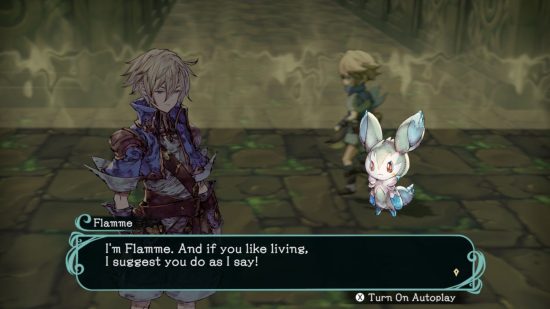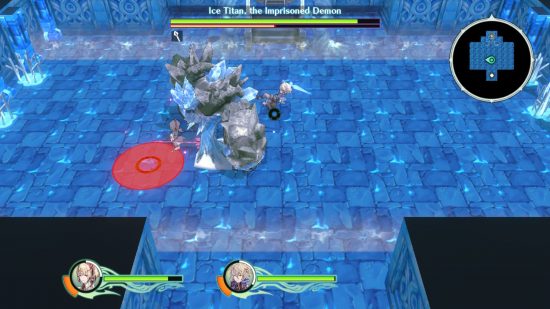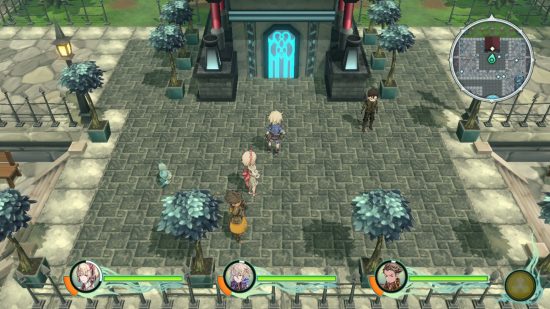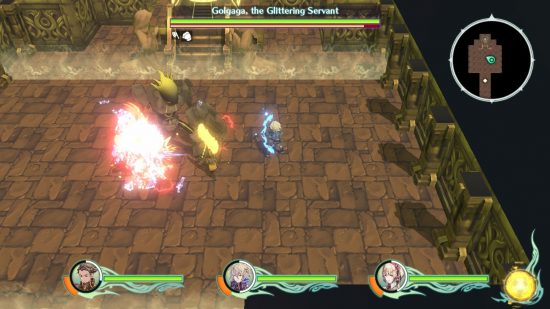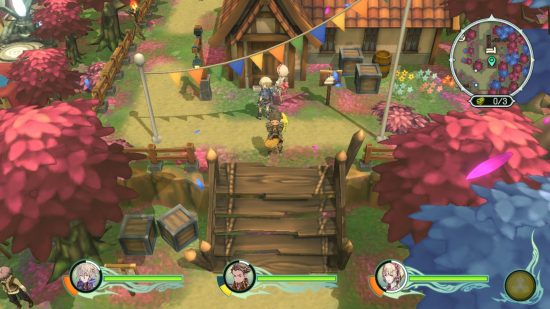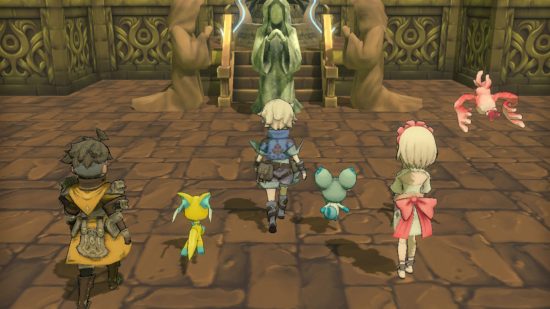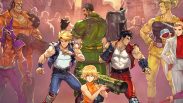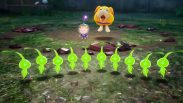Trinity Trigger is an action RPG that strives to be a ‘revival of 90s era RPG classics for the modern age’, describing itself as ‘nostalgic and moving for the adults today who were children back then, and straight fun for the children of today’, and I feel it hits that mark perfectly. With a star-studded team that would impress any fan of the genre and a unique yet familiar world to fall into, I jumped at the chance to do a Trinity Trigger Switch review – and I enjoyed every second of my time in Trinitia.
The narrative of Trinity Trigger revolves around an ancient conflict between the Gods of Order and the Gods of Chaos who fought for control of the world. During their war, great weapons fell down to the land, altering the weather and environments around them as the world began to collapse. Each god then chose a proxy known as a ‘Warrior of the Gods’ who would later battle in order to decide the ultimate winner.
Fast forward a bit, and we meet our protagonist – a pretty cool guy called Cyan, standing out from the crowd with his elegantly dishevelled hair, wonderfully RPG-esque outfit, part-time heterochromia, and a mysterious emblem over his eye. Naturally, Cyan is an orphan who has many questions about himself, his family, and the meaning of that emblem slapped on his face consistently niggles away at him.
As you’d expect, that emblem actually connotes Cyan’s status as one of those aforementioned Warriors of the Gods. Thus, despite his initial plan to live life as a simple scavenger, taking down monsters and bringing home treasures to support him and his adopted sister, he’s fated for much grander things. Grander things which include exploring far-off lands, befriending an odd little creature called Flamme who acts as a mascot-turned-tour-guide-turned-magical-weapon that you can wield in battle, and saving the world from certain doom. Y’know, all that deliciously familiar fantasy fun.
While the story has some unique twists and fun reveals, it’s certainly not trying to reinvent the wheel – and it doesn’t need to. It’s a delightful, lighthearted adventure that sets out to cater to and entertain any fan of classic RPGs or those of you looking for an easy entry point into the genre, and that’s exactly what it does.
Trinity Trigger is set in a world called Trinitia, which is split up into several different biomes, each consisting of smaller zones that conform to the biome’s unique environment. From the sinkholes of Sandheim, to the slippery ground and sharp spikes of Hopland, and even the mysterious effects of the flowers growing around Festibane, exploring each new area, meeting its residents, and learning how to tackle its hazards is always a real treat.
The overall map is a decent size, with plenty of little sidequests, challenges, collectable chests, and previously inaccessible areas to encourage you to return to locations at your own speed. The shrines that you save at throughout the game also act as fast travel points, which makes zipping around to polish everything off much more accessible.
I’m very pleasantly surprised by both the brief but beautiful 2D animated cutscenes that pop up now and then, and the brilliant voice acting. All of the main dialogue is fully voiced, and even NPCs have little greetings, grunts, or laughs that add a real sense of life to the world. The dialogue is also well-written and conversational, lacking the stiff awkwardness that often comes with translations, and the friends you meet along the way are full of personality. This all adds up to form a nice vehicle for the narrative that prevents cutscenes and story beats from getting stale.
In terms of gameplay, Trinity Trigger is a mixing pot that combines many of the best bits from classic RPGs, while still managing to remain simplistic and clean. Out of all other titles, I’d say its core mechanics are closest to Square Enix’s Mana games, only with tighter combos and more fine-tuning.
As you’d expect, the core gameplay revolves around exploring a map and fighting enemies with your ‘trigger’. Triggers are small, sentient beings that can transform into magical weapons to help you in battle, and, as you explore different ‘Armas’ (essentially dungeons set in the large weapons that fell during the war between the gods), you unlock different forms for your triggers.
You start off with just Cyan and his trigger Flamme, who can initially only transform into a sword. However, two new trigger-wielders called Ellise and Zantis join your team, each with their own weapons. As you progress through the game, you can eventually unlock all weapon types for all three triggers.
Once you have all three party members on your team, you also unlock co-op, which allows a second and third player to join in on some shared-screen fun. This drop in, drop out co-op style is a strong choice for such a comfy game, making it a great option for those of you who want to share a chill time with a loved one or friend, or to introduce a little one to the wonderful world of RPGs.
I really enjoy the variety between the weapons, as well as their customisation options. You can equip each of your triggers’ weapon types with different manatite gems that you craft or collect throughout the game, which offer boosts to a wide range of stats such as attack, defence, HP, life steal, EXP gain, and more. Each weapon also has three combo slots with two options for each slot, so you can customise your combos to suit your playstyle from the pause menu. You can also upgrade these moves at the save point shrines you find around the world.
For even more flexibility, you can switch between the three characters at the tap of a button, and you can change which weapon they wield on the fly through a shortcut wheel. These mechanics offer enough variety that you feel in control of your team and can mould certain elements to fit your personal preferences, while still remaining quite easy to grasp for players who may be less experienced in the genre. And, even if you are, like me, very well-versed in similar games, it offers a relaxing, well-balanced respite from more punishing titles.
All of this allows for quite a bit of experimentation in an otherwise simple battle system, allowing you to choose how much you want to engage in the different elements of the game. You can certainly see it through to the ending by predominantly sticking to one or two weapons per character with one maxed-out combo each. But, if you’re looking for a little more room to shape the combat around your personal playstyle or the battle at hand, there’s a decent amount of options on offer which only grows as you progress through the game, and you’re sometimes rewarded for your experimentation.
Beyond the character and weapon switching, combat has a very simple control scheme. You attack with the A button, dodge with the B button, and unleash your special attack with the X button when your weapon starts to glow. You can also hit the Y button to charge up your weapon, and hold down the A button when you’ve got three characters on your team to unleash a trinity attack. Enemies are capable of applying a wide range of status ailments, and they can chip your health down pretty quick if you don’t dodge enough, but you also have a quick-access wheel that temporarily pauses the game, allowing you to comfortably use healing, status recovery, and buffing items before you continue your fight.
There’s a nice range of enemies and enemy variations to tackle throughout the different areas of the map, each themed accordingly to fit the biomes and boasting their own strengths and weaknesses. Some apply nasty status ailments, some unleash powerful attacks that they telegraph through red marks on the floor, and some drop specific materials when you slay them with a certain weapon. All of this rewards you for showing a little tactical thought in combat, while also leaving it open for less tactical players to charge in and soak up all the damage with a couple of potions.
Overall, you won’t find much to test your skills or challenge you in Trinity Trigger, so if you’re looking for a beefy, tactically intricate action RPG to sink your teeth into, look elsewhere. It’s a predominantly laid-back experience that caters to casual players or those of you looking for something fresh to cater to your nostalgia, and it does exactly that.
The game introduces new mechanics to you at a comfortable and steady pace, often marking things out clearly at the beginning accompanied by a brief tutorial to plant a seed in your mind, then serving up opportunities for you to experiment in slightly more obscure situations later on. You can also read through the different tutorials in your menu if you need a refresher at any point. I really enjoy this natural sense of progression, and I appreciate that you have room to use all the mechanics you learn at multiple points throughout the game.
Outside of the main storyline and the combat, the side missions are rarely anything to rave about. They mostly consist of fetch quests that require you to pick up an item, talk to an NPC, or defeat some enemies. It would be nice to have a bit more variety in these, though the snippets of lore they offer do help flesh the world out and give life to the residents of the towns. There are, of course, some outliers, such as the quest from Lime that sees you enter an optional dungeon in search of a material for her which also nets you the fists weapon for Cyan, but for the most part they’re pretty basic and just net you some extra items or cash.
Aesthetically, I think Trinity Trigger is a very pretty little game. It’s set in a chibi-esque 3D world reminiscent of many other games in the genre, and both the characters and environments are charmingly simplistic, capturing the essence of traditional 3D RPGs perfectly with a nice level of polish. Though some residences look a little barren, there are still plenty of details that make the world feel lived-in, and I really like the 3D sprites for all of the characters – even though quite a few of the NPC models are frequently recycled.
The 2D character sprites that pop up during dialogue are beautiful, with a style reminiscent of Octopath Traveler. And, as I mentioned earlier, the 2D animated cutscenes, while rare, are a real treat. I’m also very fond of the designs of the different triggers, along with the grand, weapon-shaped Armas that you explore.
Performance-wise, I saw no issues throughout my playtime. Load screens are quick, and there’s no stuttering, jittering, or bugs. The controls are comfortable and intuitive, and the inputs are snappy and responsive. The UI is also well-scaled and clear, and the menus are pretty easy to navigate.
Trinity Trigger’s OST is that familiar, midi-style setup, with tracks that make me feel entirely nostalgic despite never having heard them before. Both the music and sound effects are non-intrusive and comforting, providing a nice backdrop to the action. I truly have no complaints with the sound design – that is, aside from the voicelines your playable characters spit out when using a bow, which become tiresome pretty quickly.
Trinity Trigger isn’t a massive, 50+ hour-long epic like others in the genre, and, if you’re an RPG fan, you may well blast through this quicker than you’d like – I’d estimate it takes around 15-20 hours for the average player to complete everything. However, I feel it offers a decent amount of content through its main storyline and optional combat. It doesn’t outstay its welcome, and the content it does offer is overall well-crafted, thoughtful, and satisfying.
Personally, I’d say $49.99 (£44.99) for the base edition may be a bit steep for some players considering Trinity Trigger’s scope and length. However, it’s certainly a beautifully made game with great voice acting, an enjoyable story and characters, and an interesting yet simplistic and easy-to-grasp combat system.
It’s wholesome, cosy, and acts as a charming love letter to the golden age of the RPG while still maintaining its own sense of identity, making it enjoyable for fans of the genre and new players alike. Its nostalgic, comforting vibes won me over from the start, and it continued to deliver throughout – and I look forward to many more visits to Trinitia in the future.
If you’re on the hunt for even more adventures to embark on, check out our lists of the best Switch RPGs and the best mobile RPGs. Or, if you fancy something a bit more out of this world, head over to our Honkai Star Rail tier list and Honkai Star Rail codes guides.
Trinity Trigger Switch review
Trinity Trigger is a familiar, fun-filled fantasy that features a unique yet simplistic battle system, a cosy, fantasy-fuelled narrative, and a cast of adorable characters. It certainly lives up to its goals of being a nostalgic and moving revival of 90s-era RPG classics, and makes for a brilliant, bite-sized adventure for RPG fans and newbies alike.
